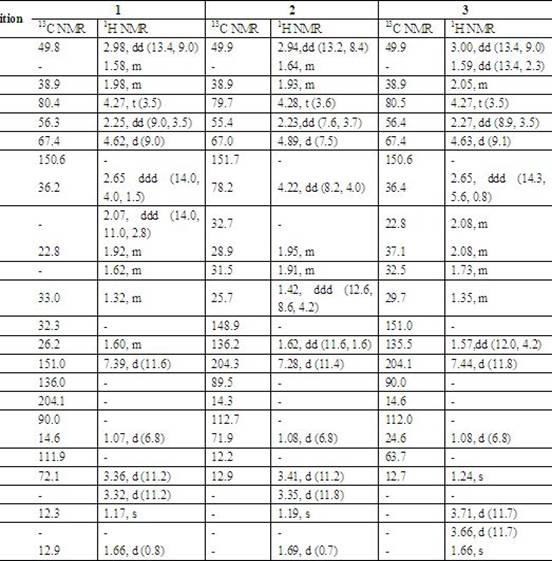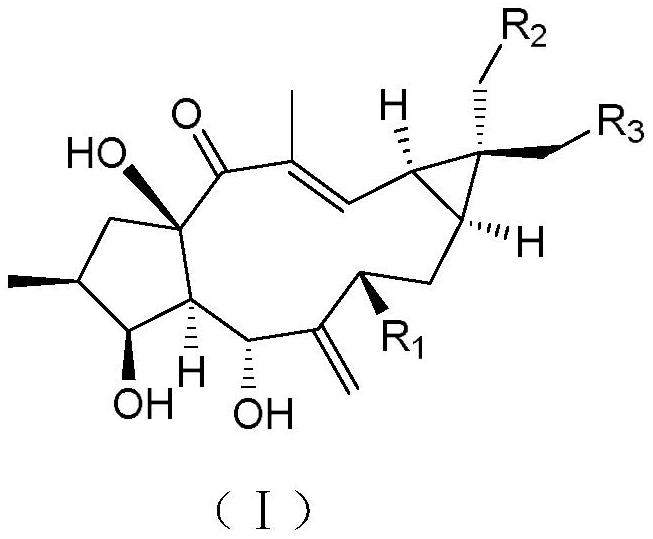Transformation method of hydroxylated capers diterpenoid derivatives and its use in the preparation of antitumor drugs
A technology for biotransformation and microbial transformation, applied in the field of biopharmaceuticals, and can solve problems such as reports on the microbial transformation of diterpenoids that have not yet been reported.
- Summary
- Abstract
- Description
- Claims
- Application Information
AI Technical Summary
Problems solved by technology
Method used
Image
Examples
Embodiment 1
[0026] Example 1 Preparation of 18-Hydroxy Capper Diterpene Alcohol (1) and 19-Hydroxy Capper Diterpene Alcohol (3)
[0027] The two-step activation method was used to activate the strains, and the obtained seed solution was inoculated at 1% volume ratio in a 1 L Erlenmeyer flask containing 250 mL of potato medium, and cultured in a shaker flask at 28 °C and 180 rpm for 48 h. Add 5 mg / mL ethanol solution of Capper diterpene alcohol to each bottle of activated bacterial liquid, and the final concentration is 0.1 mg / mL. After culturing under the same conditions for 72 h, the fermentation broth was suction-filtered, and the filtrate was extracted three times with ethyl acetate, and the ethyl acetate was recovered after merging to obtain the fermentation broth extract;
[0028] Dissolve the extract of the fermentation broth with a small amount of ethyl acetate, mix the sample with silica gel (100-200 mesh), load the sample on a silica gel column equipped with 40-50 g column chroma...
Embodiment 2
[0029] Example 2 Preparation of 7β, 18-dihydroxycapricorn diterpene alcohol (2)
[0030]The two-step activation method was used to activate the strains, and the obtained seed solution was inoculated at 1% volume ratio in a 1 L Erlenmeyer flask containing 250 mL potato medium, and cultured in a shaker flask at 28 °C and 180 rpm for 48 h. Add 5 mg / mL ethanol solution of 7β-hydroxycapricorn diterpene alcohol to each bottle of activated bacterial liquid, and the final concentration is 0.1 mg / mL. After 72 hours of culture under the same conditions, the fermentation liquid is suction-filtered, and ethyl acetate is added to the filtrate. Extracting 3 times, reclaiming ethyl acetate after merging, and obtaining the fermentation broth extract;
[0031] Dissolve the extract of the fermentation broth with a small amount of ethyl acetate, mix the sample with silica gel (100-200 mesh), load the sample into a silica gel column equipped with 40-50 g column chromatography silica gel (200-300 ...
Embodiment 3
[0035] Example 3 Preparation of 18-Nicotinyloxy Capper Diterpene Alcohol (4)
[0036] Take 10 mg of dry and anhydrous 18-hydroxyeuphorbia factor L3 (1) in a 50 mL round bottom flask, add 10-15 mL of anhydrous tetrahydrofuran, add 8 mL of triethylamine, a trace of 4-dimethylaminopyridine (DMAP ), stir and dissolve with a magnetic stirrer, add 1 equivalent of nicotinoyl chloride hydrochloride under ice bath conditions, stir and react together to room temperature for 8 hours, if the reaction is not complete, then reflux and heat for 1 to 3 hours;
[0037] Check whether the reaction is complete: use a capillary to absorb a small amount of reaction solution, spot on a silica gel thin-layer plate, and spot 18-hydroxycapricorn diterpene alcohol in parallel, and use dichloromethane-methanol (20:1) upward method to develop. Take it out to dry, and inspect it under a 254 nm ultraviolet light. The sign of the completion of the reaction is that there is no bright spot or only a faint brig...
PUM
 Login to View More
Login to View More Abstract
Description
Claims
Application Information
 Login to View More
Login to View More - R&D
- Intellectual Property
- Life Sciences
- Materials
- Tech Scout
- Unparalleled Data Quality
- Higher Quality Content
- 60% Fewer Hallucinations
Browse by: Latest US Patents, China's latest patents, Technical Efficacy Thesaurus, Application Domain, Technology Topic, Popular Technical Reports.
© 2025 PatSnap. All rights reserved.Legal|Privacy policy|Modern Slavery Act Transparency Statement|Sitemap|About US| Contact US: help@patsnap.com



